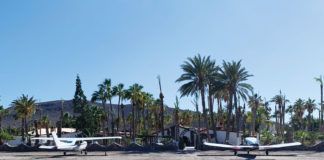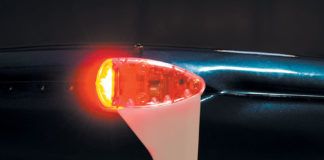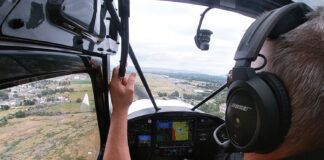Getting to 81D, aviation record-setter Bruce Bohannons rural grass airfield south of Houston, is a lot more fun by air than it is by ground. From the air you track state highway 288 south of Houston and watch for a racetrack off to the east. Look for the distinctive V of Bohannons well-groomed runways, with their water hazard in the crook (a nod to his +6 handicap golf days). If you come upon a cell tower or, worse, the Gulf of Mexico, you’ve gone too far. Turn around and head north again, and look closer!
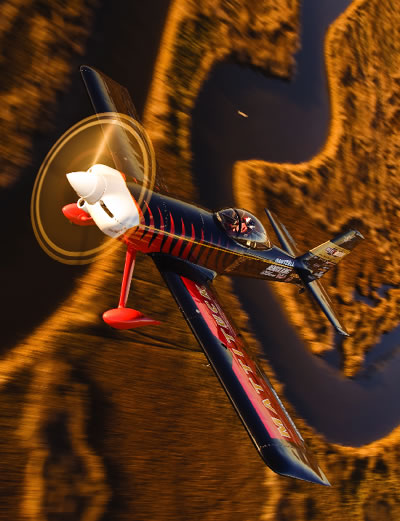
From the ground you steer on interstate, then state, then county roads until you run out of pavement and just about then you’ll come upon a grove of planted oak seedlings. Turn right there. (Odds are you’ll see Bohannon in his Legend Cub approaching to land directly over you. Just follow it, and you’ll be fine.)
The two roughly 2200-foot-long golf-green turf runways are angled right for most of the wind, with trees and a ditch at one end (and a stop sign if you get that close), with a fence and a dirt road at the other (watch for the dump trucks, and time landing approaches accordingly). Bucolic is the best description for the setting (especially if you came by ground through downtown Houston traffic).
A long hangar lined with workbenches dominates the property. Inside it are ATVs, a much-loved rat terrier and cats to keep the mice down, a tractor for mowing, a backhoe with a lift arm, and tucked in among all of this are a couple of sweet flying machines, one of which airshow attendees will recognize at 100 paces: Flyin Tiger. It sits behind a newly refurbished Vans RV-4 that was its builders inspiration some 13 years ago.
Bohannon leans over the Tiger, contemplating a flight. It isn’t long, though, before we are joined by friends including astronaut, air racer and erstwhile Southwest Airlines Captain Hoot Gibson, dropping by for an impromptu barbecue in the afternoon, inspired by a buddy who brings ribs that were probably made in heaven. The Legend Cub gets a workout hopping rides, the refurbished RV-4 makes low passes, and even the Flyin Tiger soars before the sun slides too far west. All the while, Bohannon talks, and his wife, Donah, a pilot herself, chimes in here and there. The tales, all true, get taller as the afternoon shadows grow longer.
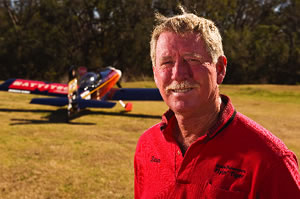
Bruce Bohannon began his flying career as the ground crew for cropdusters in Alvin, Texas, in the late 1960s. By the early 1970s he was flying them, and it has been up from there.
Dont Mess with Texas
Bohannon has not drifted far from his roots in pursuit of his more than 30 aviation world records, most set in the famous Flyin Tiger homebuilt for which his airfield is named. He was born in nearby Alvin, Texas, at the end of the 1950s as one of a crowd of seven kids. He learned early from his mother that if he earned the money, he could buy the toy. By 13, one of those toys was a Kawasaki 250 street bike, much to his mothers chagrin, but he got to keep it (ostensibly by throwing her words back at her, he recalled).
Working ground crew for crop dusters at a nearby airstrip earned Bohannon the cash he needed for what he really wanted to do: fly. Flight school was far more interesting to him than high school, and by the time he was 18 hed earned his commercial certificate and graduated from ground crew to flight crew. Hed fulfilled dream No. 1, and was making money at it, too.
Clover Field, Texas (now Pearland Regional Airport, KLVJ), just north of Alvin, became the nexus for Bohannons second dream. In a hangar next to his, Hoot Gibson kept his things. Bohannon dabbled in competition aerobatics with a Pitts biplane, and segued from that into racing (it seemed, at the time, less subjective). Gibson was setting records in his homebuilt Experimental Cassutt out of that hangar, and from watching the two men, it is easy to see that theyve spent some quality time together. Bohannon is quick to point out that if it were not for Gibsons advice at key moments on both his Pushy Galore and Flyin Tiger projects, events might not have played out so well.
Team Tiger
For instance, Bohannon says, most people know that Gibson helped design the canard for Pushy Galore, the racer Bohannon had built after one beat him in the Pitts at Reno. Hoot said, Set it at 2, and itll hold up 15 pounds, Bohannon recalled. Gary Hunter, his mechanic, and a genius with foam and fiberglass created the canard, and they attached it to the airframe. It worked, but that wasn’t enough to make Pushy Galore an easy, or even safe airplane to fly, according to Bohannon. That airplane darned near ruined me, he said, shaking his head. It was just thatscary to fly. Pushy had no roll control, and its structure was inherently weak. I think if youd have hit a bird at the wrong angle, that wing would have shattered like a light bulb. There were only four airplanes like Pushy built, and two came apart. Those are not good odds. And I couldn’t in good conscience sell it, he said. Instead, the airplane now resides in the EAA Museum at Oshkosh, Wisconsin, and alongside it is a description of the time-to-climb records it still holds in the Class C.1a (661 to 1102 pounds). My kids played in that airplane when I was building it in the living room, Bohannon said. Its emotional for us to see it there, and to sit in the Hilton Welcome Theater and watch the film with us in it.
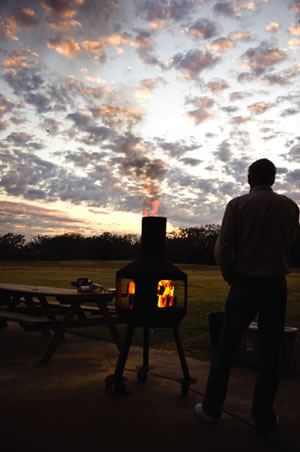
There are few places in the world as beautiful as Southeast Texas at sunset. Flyin Tiger Field is an active privately held, public use airport with weekly impromptu get-togethers and flying. The Bohannons have a lot to be proud of.
That got Bohannon more attention than hed expected from one KPRC broadcaster named Donah. The news director told me to go interview him, and he was Mr. Soundbyte, Donah said. The two began to cross paths with some frequency as Donah transitioned from her broadcast career to one at the Houston FSDO, and about the time she learned to fly, she started dating Bohannon, then a single father of two.
All my friends made such fun of me for dating a Fed, Bohannon said, remembering the first time he took Donah to a hangar party at what was then Clover Field. I did the only logical thing. I hired her to come over and be my press agent. And then they all made fun of me for hiring a Fed, so I married her, and you know, they made fun of me for that! So I decided my friends are all a bunch of jerks who don’t know anything, and its been fine since, he said, grinning.
Rediscovering the Joy of Flying
The revamped RV-4 was the airplane Donah ultimately flew chase plane in for him with the Tiger. I inherited this RV-4 project from Grant Doressett, Bohannon said. He brought it to my house in a Ryder truck and dropped it in my driveway, telling me that he wanted me to buy it from him. We haggled, and I did. It sat for months, and finally I told myself I just ought to put it together and see. Well, the first flight in that airplane is where I rediscovered the joy of flying. I said, now this is what a plane is supposed to fly like. I knew that moment that my next airplane would be out of the RV lineage.
The Flyin Tiger, however, is no RV you could build from a kit. At least, not one kit. When we were about to build the Tiger, I went to Dick VanGrunsven and told him what I wanted to do, why I wanted to do it, and that I wanted him to build it for me, Bohannon said. He looked at me as if I had three heads! He said, Uh, No. But VanGrunsven is not unreasonable. He told Bohannon that if anyone could pull this off, it was him. He knew that Pushy was a ridiculously dangerous airplane. He told me he would never endorse it, and he did not want me to call it an RV. And I never did, Bohannon said.
Instead, he correctly tells people that they built the Flyin Tiger out of some RV parts. Specifically there were RV-4, -3, -6, -8 and Harmon Rocket parts and a lot of their own stuff blended all together into one airplane. Sure, hell admit that the majority of the parts are RV-4 related, but out of respect for VanGrunsven he would never call it that. It is a junkyard dog, a composite of many different things that worked well. For example, the canopy release mechanism is straight out of a Pitts. The wing, which Bohannon insists flies as beautifully at 47,000 feet as it does at 4700 feet, is a tried-and-true NACA 2300 series. The stretched looking fuselage was designed to hold a set of golf clubs, or the nitrous injection system that initially boosted the Tigers engine power, and then the pressure-breathing oxygen system that helped Bohannon survive the trip up and back from those rarified altitudes. They stirred it all up and came out with something magical.
For the Record
With this airplane and generous sponsorship for seven years from Exxon, Bohannon has set 30 world records, 13 of which are in the unlimited class. Hes gone 0.5 Mach straight and level in this airplane. At 40,000 feet, on the way to another record, he held Flyin Tiger level for 90 seconds, and the airplane accelerated to 167 mph indicated. When the weather data was extrapolated and the temperature recorded, that turned into 325 mph true airspeed. He retired the airplane after its last record-setting run to more than 47,000 feet, content that hed gotten as close to 50,000 feet as made sense (and without a pressure suit, but that is another story).
Bohannon is quick to point out that no one person, of all of the people he surrounded himself with over the years, could have set these records alone. It took a team, he says. Gary Hunters fiberglass skills are second to none, and Mark Frederick is just a genius with sheet metal. Cowboy cropduster Andy Christians mechanical problem-solving prowess got us through so many things…Hoot Gibsons NASA connection saved my hide…and probably my life at one point. And Scott Crossfields great advice…I really miss him.
So what does he have up his sleeve for his next act?
I hope that if the Smithsonian Institution in Washington, D.C. wants it, we can find a donor who can afford to purchase the Flyin Tiger from us and donate it to the museum, he says. There are so many great airplanes there, and wed really like this airplane to be among them. Bohannon has participated in the Smithsonian Be-A-Pilot Day (held each June as a fly-in event at the Udvar-Hazy Annex at Dulles National Airport). It is such a neat thing to see my airplane there on the ramp, he says. To see it hanging from the ceiling inside would be just fantastic.
For the time being, Flyin Tiger gets to stretch its paws on short demos for the friendly barbecue crowd on Saturdays at its namesake strip. From a dead standstill the Tiger can still climb 5000 feet by the end of the 2200-foot runway, and thats without the Kelly Aerospace turbocharger and intercooler and manually controlled laser timing that allowed Bohannon to set so many records in it. And yeah, it still roars as it flies by. He also uses it for cross-country trips, because, at altitude, its still one of the most efficient (not to mention quick, at an average of 240 mph) airplanes hes ever flown.
When hes not letting the cat breathe, Bohannon is specializing in emergency training regimes for pilots seeking him out. He rents the Legend Cub for $125 per hour solo, and $50 more per hour with him. In about 3 hours of flying we can go through the logic of how to react in an engine-failure situation, he explained. We do have a starter on the Cub, and we do go all the way to shutting the engine off and stopping the propeller in flight. And Ill tell you it gets peoples attention when they realize they are no longer in powered flight, they have to make their landing spot, and it better be a good one, he said. It is also incredibly empowering for pilots once they see positively that they can handle the airplane in a power-loss emergency and get down safely.
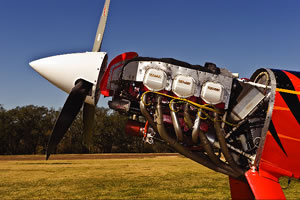
The Mattituck IO-555 purpose-built engine was modified several times over the years. It had a nitrous injection system, and then a much more reliable Kelly Aerospace intercooled turbocharger and manually adjustable laser timing system.
Bohannon is open to flying with pilots in their own airplanes, if they are the kinds of machines that can be operated safely in and out of Flyin Tiger Field. He admits that in his post-Pushy Galore days hes actually turned down flying an airplane or two, but not many.
Ive worked with a couple of primary students this year, says Bohannon. One of them got a pilots certificate in 46 hours, and the other in 42. Im proud of that. The Legend Cub we bought in February of 2007, he says, puffing up just a little, and two years later we’ve put more than 500 hours on the airplane. We do tailwheel transitions with it, too, and that is something I really enjoy. I would teach aerobatics, but I don’t have the right airplane to do that right now. If someone wants to learn in their own airplane, Im no Sean Tucker by any means, but I can teach, he says.
Hatching a Plan
Most recently Bohannon checked out in the DHC-6 Twin Otter at the local skydiving drop zone and has since flown about 100 hours worth of skydivers (he enjoys skydiving on occasion, too). Oddly, thats become the inspiration for his next great marketing idea.
Im thinking that there might be something to getting a Twin Otter and putting it on amphibious floats and using that for a marketing platform for someone. I just love the airplane. It is a jet engine Cub. I fell in love with it the day I started flying it. It would be really neat to have a job flying one around the country. With 10,000 airplanes on the field at an airshow, that one would be talked about, he said, smiling. You could land it on a lake, take it to a boat race, and it stands high-
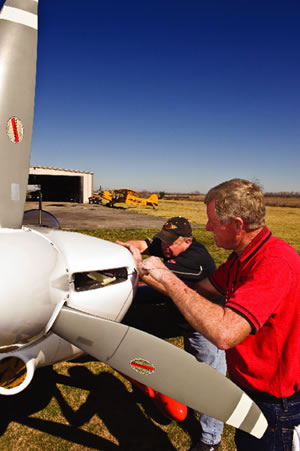
Gary Hunter (left), who Bohannon calls a genius with fiberglass helps Bohannon with the cowling that he created.
Donah interrupts him here, laughing. And you can jump out of it!
He smirks, and keeps talking. You can carry a ton of stuff on it. Leave the seats in it and you can do incentive rides for employees. You could literally put one of everything in your store in that airplane and go from show to show, and it is a big machine, great for painting a logo on it. I can see us digging a water runway right on the other side of our grass strip. That airplane is so big and impressive, and they are out there. I saw a picture of 25 of them floating on a lake in India. His eyes sparkle as he talks, pointing to the tree line on the far end of one side of his grass V landing area. You can see the wheels turning in his head, and you know hes serious, no matter how farfetched the adventure seems in the moment.
The only downside Bohannon can think of? It is expensive, he said. But then he points out that good marketing isn’t cheap. We’ve never picked up a major sponsor when times were really good, so… he shrugged. Smart companies know that when times are tough, that is the moment to separate yourself from the pack and get people to notice you. Figuring it that way, we should have a new sponsor pretty soon! With Bohannons luck, he will.
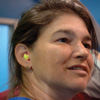
![]()
Amy Laboda holds an Airline Transport rating, multi-engine and single-engine flight instructor ratings, and glider and rotorcraft (gyroplane) ratings. She and her husband live in Florida, along with two daughters, and recently finished building a Vans RV-10.


